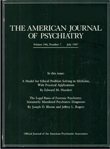Effects of methylphenidate on regional brain glucose metabolism in humans: relationship to dopamine D2 receptors
Abstract
OBJECTIVE: The authors' goals were to determine whether baseline dopamine activity contributes to response to methylphenidate and to assess the pattern of metabolic responses associated with enhanced dopamine activity. METHOD: They used positron emission tomography with 2-deoxy-2[18F]fluoro-D-glucose to evaluate the effects of two sequential doses of methylphenidate on brain metabolism in 15 healthy subjects. Dopamine D2 receptor availability was measured with [11C]raclopride to evaluate its relation to methylphenidate-induced metabolic changes. RESULTS: Methylphenidate increased brain metabolism in six subjects, decreased it in two, and did not change it in seven; however, it consistently increased cerebellar metabolism. Methylphenidate significantly increased "relative" (region relative to the whole brain) metabolism in the cerebellum and decreased it in the basal ganglia. Regional metabolic changes in the cerebellum and the frontal and temporal cortices were significantly correlated with D2 availability. Frontal and temporal metabolism were increased in subjects with high D2 receptors and decreased in subjects with low D2 receptors. CONCLUSIONS: Methylphenidate induced variable changes in brain metabolism, but it consistently increased cerebellar metabolism. It also induced a significant reduction in relative metabolism in the basal ganglia. The significant association between metabolic changes in the frontal and temporal cortices and in the cerebellum and D2 receptors suggests that methylphenidate's metabolic effects in these brain regions are due in part to dopamine changes and that differences in D2 receptors may be one of the mechanisms accounting for the variability in response to methylphenidate.



